Tips for Positioning and Choosing the Right Rug Size for Each Room in Your Home
Deciding on the appropriate size and placement for a rug can be daunting. However, we’re here to assist you in finding the ideal rug for each room in your house. As a rule, there should be at least 15 to 30 cm of space between the rug and the walls for optimal aesthetics. Refer to the simple guidelines below to ascertain the correct rug size for your space.
Bedroom
What should be the dimensions of a bedroom rug? The size of the bed can guide the selection of the rug size in a bedroom. A rug measuring 1.5 x 2.4 or 1.8 x 2.7 m is suitable for single or double beds. For a queen-size bed, the standard rug size is 2.4 x 3 m, and for a king-size bed, it’s 2.7 x 3.6 m. Don’t forget to measure the room to ensure the rug fits properly.

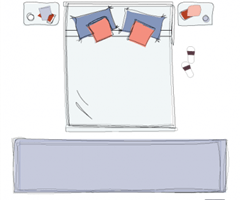
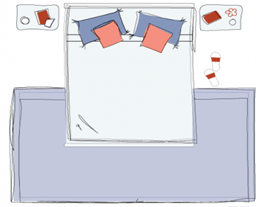

Consider placing a rug under the bed. It not only defines the space and safeguards the floor from scratches but also offers a warm and cozy surface for your feet in the morning. Position the rug under the lower two-thirds of the bed, extending it horizontally with surplus on the sides and front. This arrangement helps segment the space and provides a soft surface for walking.
Alternatively, you can opt for a larger rug that accommodates all the furniture.
Living Room
The living room, being the heart of your home, requires a rug that not only enhances its aesthetic appeal but also contributes to a welcoming and comfortable atmosphere. The size of the rug plays a crucial role in achieving this balance.
When selecting a rug, consider its size, material, and style. The placement of the rug in relation to the furniture can guide its dimensions. Opt for a durable rug that complements the overall design of your room.
The standard size for a living room rug is approximately 3 x 4 m. However, this may vary based on the room’s dimensions. For instance, the average living room measures 5 x 6 m, but in some apartments, it could be 3 x 4 m or 2 x 3 m. Therefore, the ideal rug size for smaller apartment rooms may differ from that for larger houses. Considering the dimensions of your room and furniture can help determine the perfect rug size.
For a small living room measuring 3 x 3 m, a 2.5 x 2.5 m rug is recommended. This size ensures a 3.5 m space between the rug and the walls on all sides. For a 2 x 3 m space, a 1.5 x 2.5 m rug is usually suitable, maintaining a 3.5 m edge between the rug and the walls. In small living rooms, the back of the sofa and chairs are typically against the wall, with only the front legs on the rug.
In contrast, larger living rooms, typically about 7 x 10 m or more, can accommodate all the furniture on the rug’s surface, adding a touch of elegance. For most 5 x 6 m living rooms, a 3 x 4 m rug can be suitable, providing enough space between the rug’s edges and the walls for flexibility. A 7 x 10 m living room would look good with a 4 x 5 m area rug. In large rooms, the furniture is further from the walls and on the rug. Usually, all four legs of the sofa and chairs fit on it. Alternatively, you can place only the front legs of the sofa on the rug, creating more space in the center of the room.
. For most 5 x 6 m living rooms, a 3 x 4 m rug can be suitable, providing enough space between the rug’s edges and the walls for flexibility. A 7 x 10 m living room would look good with a 4 x 5 m area rug. In large rooms, the furniture is further from the walls and on the rug. Usually, all four legs of the sofa and chairs fit on it. Alternatively, you can place only the front legs of the sofa on the rug, creating more space in the center of the room.


Dining Room
The question of whether to place a rug under a dining table is often asked. The answer is affirmative. Despite some designers’ differing opinions, a rug under the dining table is highly beneficial. It not only defines the space but also protects the floor from scratches and spills. Moreover, it provides a warm and inviting surface for your feet.
A flat fabric rug, such as a Soumak, or a short pile rug is preferable for the dining room due to their ease of cleaning. Food spills are inevitable around the dining table, and high pile rugs can obstruct the movement of chair legs. The positioning of the rug should be determined by the size of the table, chairs, and room area.
The standard size for a dining room rug is approximately 3 x 4 m. This creates a frame for the space, enhancing the coziness for guests and family dinners. The average dining room measures about 4 x 5 m.
The sizes of rugs for a dining table and chair set also depend on your furniture’s dimensions. Ideally, the chair legs should remain on the rug even when guests pull the chairs back to stand up.
To determine the right size rug for the dining room, consider the dimensions of the dining table and the dining room itself. The rug under the dining room tables should be at least 70 cm larger on all sides, allowing the chairs to move back and providing space for seated guests.
The best rug size for dining rooms (and any room) should maintain at least 30 cm of space between the edges of the rug and the walls.

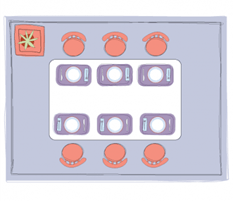
Start by measuring your dining room table and adding 1.2 m to each dimension. Then, compare the results with the room size to ensure that the rug is at least 60 cm smaller on each side, keeping the rug 30 cm away from the wall at all points.
Another alternative is to find the largest rug that fits in the dining room and choose the table size accordingly. For example, if the room is 3 x 4 m, you can place a 2.4 x 3 m rug in this space. From there, you will decide what size table to use for a 2.4 x 3 m rug by subtracting 1.2 m from each dimension, leaving you with a 1.2 x 1.8 m dining table or smaller.
Entrance Hall
The size of the entrance hall and the amount of traffic it receives will determine the rug size. The rule is to keep at least 45 cm of exposed floor between the rug and the wall. Smaller spaces can have less exposed floor area. Runners can be placed in long, narrow entrance halls. Try a 0.6 x 1.8 m or 0.6 x 2.8 m rug to protect your entrance area. Entrance rugs can be small if your space is small. A 0.6 x 1.0 m or 1.0 x 1.5 m rug is sufficient. A 1.2 x 1.8 m rug can be placed in a medium-sized hall. This size will provide more coverage, perfect for a space with some furniture at the entrance. Similarly, larger entrance halls require larger rugs. Try a 1.5 x 2.4 m or 1.8 x 2.8 m rug to welcome your guests with elegance.
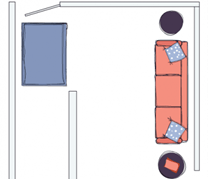
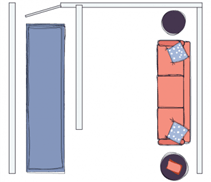

Figalli Oriental Rugs
We do not sell rugs. We bring rare works of art to your home in the form of rugs.
Our services
You are Protected
Copyright © 2023 Figalli Oriental Rugs, All rights reserved. Desenvolvido por Agência DLB – Agência de Marketing Digital em Porto Alegre
